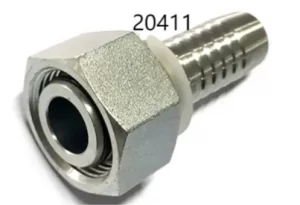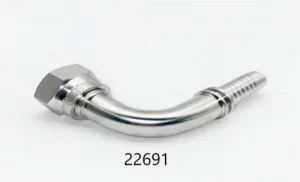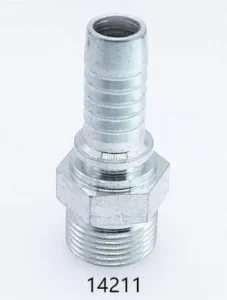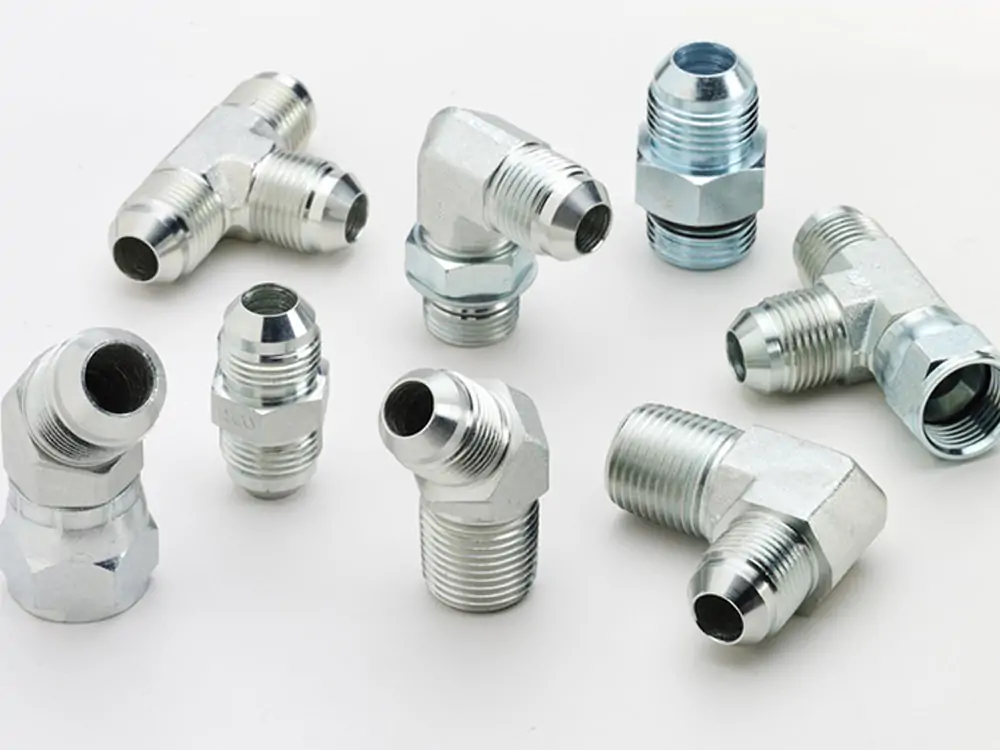Choosing the right hydraulic fittings and suitable hydraulic hose is essential. Since the options for hydraulic hoses are vast, hydraulic hose fittings also come in diverse types. Each of these types is ideal for specific types of hydraulic hoses. Therefore, understanding the fundamentals of different hydraulic fittings is necessary.
This article aims to create a comprehensive guide on the fundamentals of hydraulic fittings. It highlights different types and their properties. In addition, it also provides a guideline for perfect installation. We hope it will be an excellent guide for our readers, especially beginners.
What Are Hydraulic Fittings?
Hydraulic fittings are typical components used in hydraulic systems. It connects, controls, and directs the flow of hydraulic fluid between various hydraulic parts. Some popular hydraulic parts are pumps, valves, cylinders, and hoses. Various hose fittings ensure hydraulic systems’ proper functioning and efficiency.
Hydraulic fittings provide secure and leak-free connections. In this case, sealing elements such as o-rings and gaskets are used. They allow hydraulic systems to send power and control machinery. Besides, hyd fittings are specially designed to withstand specific pressure levels. The material used for these components is generally steel, stainless steel, brass, or aluminum. The material depends on the system pressure, fluid compatibility, and environmental conditions.
Hydraulic fittings come in three primary connection types. These connection types include tapered thread, metal seal, and soft seal connections. Besides, there are other types, such as flared, push-to-connect, and quick disconnect. The specific connection type depends on the application, pressure rating, and ease of installation.
Hydraulic fittings are prevalent in every industry and machine that requires hydraulic systems. In construction equipment, hydraulic fittings are popular. Excavators, loaders, bulldozers, and cranes are some popular applications of hydraulic systems. Besides, machine tools, manufacturing equipment, and hydraulic power units need high-quality hydraulic fittings. Again, hydraulic pipe fittings also find applications in agriculture, automotive, aerospace, and marine.
Popular Types of Hydraulic Fittings
The experts have characterized hydraulic fittings by their unique designs and features. It was mainly based on specific connections and functionalities. Different hyd fittings types vary based on thread type, regional standards, and connection method. The following seven hydraulic fittings are the most popular types in most hydraulic systems.
1. Ferrules
Ferrules are the primary types of hydraulic hose fittings. They are like metal sleeves or collars that secure and reinforce the connection between a hydraulic hose and a fitting. Ferrules are crimped onto the hose using a specialized crimping tool. There are various models available at Rentone hose from 00110 to 03310.
They are found in industrial hoses, specially made for hydraulic rubber and thermoplastic hoses. Besides, ferrules are also prevalent in other industries. Reusable ferrules have a screwing method, whereas permanent connections need a crimping machine. Ferrules play a crucial role in ensuring the integrity and performance of the hydraulic system. So, choosing the right ferrules is necessary for reliable and efficient hydraulic connections.

2. Metric Hose Fittings
These types of hydraulic connections come with metric-sized dimensions. Metric hose fittings follow metric standards that are based on SI units. Besides, ISO 8434-1 and DIN 2353 specifications are crucial for these hydraulic fittings. Generally, these hydraulic fittings feature a parallel or tapered thread design. You may choose from a variety of options.
The advantage of metric hydraulic fittings is their compatibility with metric-sized hydraulic components. Metric hose fittings ensure a proper fit and secure connection for these components. You may find its application in most European hydraulic systems. But, consider pressure rating, thread size, and material compatibility when selecting these fittings. It is necessary to ensure proper installation and crimping of the fitting.

3. British Hose Fittings
These hydraulic fittings are also popular as BSP fittings. BSP stands for British Standard Pipe. These hydraulic hose fittings follow British thread design and dimensions standards. BSP fittings are widely popular in the United Kingdom and countries that follow British standards.
Like metric hose fittings, BSP fittings also use parallel or tapered threads. At Rentone hose, the available BSP models are 12611-RW, 22211, 22611, 22691, 22141, 22192, and 22241. These models are available in various configurations based on different connection requirements. Some popular BSP fittings include adapters, couplings, connectors, elbows, tees, and plugs.

4. American Hose Fittings
Like other hydraulic pipe fittings discussed above, American hose fittings are popular today. They are also popular as SAE fittings. SAE stands for Society of Automotive Engineers. These fittings are widely used in the hydraulic systems in the United States. They are also popular in many countries that need American standards.
When selecting American hyd fittings, consider thread size, pressure rating, and material compatibility. Follow the standards when installing American hydraulic fittings with proper sealing techniques. It is necessary to achieve reliable and efficient hydraulic connections. It also ensures optimal performance in hydraulic systems.

5. O-ring Fitting
These fittings are also popular as O-ring face seal fittings or ORFS fittings. They use an O-ring to create a leak-free seal between the fitting and the hydraulic component. These fittings are ideal for use in high-pressure hydraulic systems. O-ring hydraulic fittings feature a flat face with a groove that holds the O-ring in place. When you tighten the fittings, it compresses the o-ring and creates a tight seal.
O-ring fittings are known for their resistance to leakage, durability, and ease of assembly and disassembly. O-rings can handle high-pressure applications. So, they are suitable for use in the automotive, manufacturing, and construction industries.
6. Hydraulic Couplers
Hydraulic couplers also known as hydraulic couplings or hydraulic quick disconnects. They are a specific type of hyd fittings that provide quick and easy connection. Hydraulic couplers are a subcategory of hyd fittings. They serve a distinct purpose in hydraulic systems.
Hydraulic couplers come with two main parts, male and female half. They are specially designed for convenience and efficiency. They usually come in various designs, sizes, and connection types. It has diverse types to accommodate different requirements. While selecting the couplers, consider flow rate, pressure rating, and compatibility.
7. Hydraulic Hose Adapters
Hydraulic adapters are also a subcategory of hydraulic fittings. It is also known as hydraulic fittings adapters or hydraulic connector adapters. These components usually ease the connection between hyd fittings or hoses. It is ideal for those applications which may need compatible interfaces.
Hydraulic adapters act as a type of fitting or connection into another. They come in various thread sizes, connection types, or configurations to ensure a secure and leak-free connection. Hydraulic adapters may have metric to British or American standards about thread types.

How to Install Hydraulic Hose Fittings
Installing hyd fittings needs careful attention to detail. It ensures a secure and leak-free connection. Here are five primary steps that you can follow:
Step 1: Cut the hose and prepare the end
First, measure and cut the hydraulic hose based on your specific requirements. In this case, use a suitable cutting tool. While cutting the hose, ensure a clean and straight cut. After cutting the hose, remove debris or dirt from the hose end using compressed air or a cleaning tool. In this case, ensure that the inner tube and outer cover are contaminants-free.
Step 2: Select the appropriate fittings and insert the hose into it
This step is tricky because it involves choosing the most suitable product for your project. The appropriate hydraulic fittings ensure the efficiency of your hydraulic system. Choose the hydraulic fitting that matches the hose size, type, and required connection method. After that, slide the fitting onto the hose end. They are ensuring that the two components are correctly aligned and fully inserted. At last, make sure any O-rings or seals are in place.
Step 3: Crimp or assemble the fitting
In this step, you can follow the manufacturer’s instructions to crimp. In this case, use suitable crimping to install the hose into the fitting. Some crimping machines may not provide perfect gripping. Therefore, it is essential to check your device before crimping. Apply the appropriate amount of force for a secure connection.
Step 4: Conduct Visual Inspection
After crimping the fittings, inspect the assembled fitting to ensure proper alignment. You should also ensure no visible defects or irregularities. Also, check for any signs of leakage or improper installation.
Step 5: Install protective caps and test the connection
Protect it with a protective cap after successfully crimping and conducting the inspection. In this case, you can also use protective plugs to prevent dirt or contaminants from entering the hose or fittings.
Once the protective cap is installed, perform a pressure test to check for leaks or other issues. In this case, follow safety protocols during the testing process.
Conclusion
Hydraulic fittings are crucial in ensuring secure and leak-free connections within hydraulic systems. They come in various types, each suitable for specific applications. Proper installation techniques are essential for achieving reliable and efficient hydraulic systems. Moreover, regular maintenance and inspections are also necessary for long-lasting hydraulic systems.
Above all, we recommend consulting professionals for better decisions. It is necessary when choosing the correct fitting for their application. Rentone Hose keeps one of the best customer service teams in this case. You can ask all your queries and get satisfactory answers from them.
